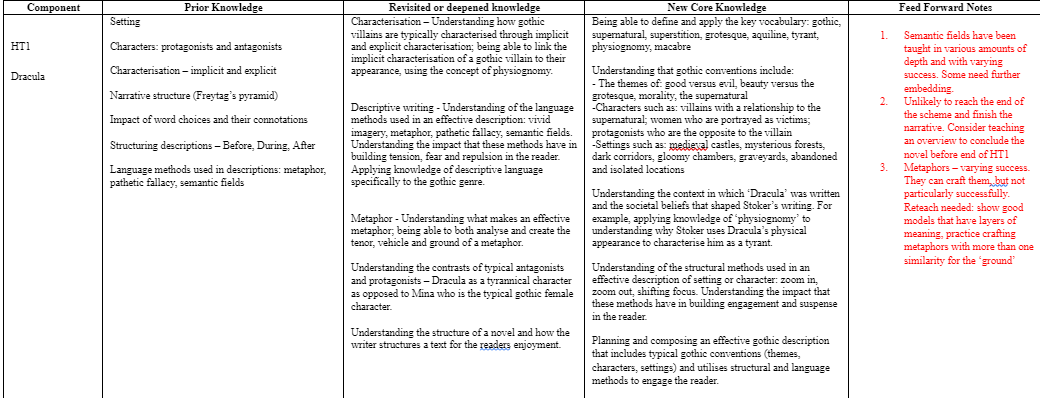Building a mastery curriculum
Developing depth and nuance using ‘Core Knowledge Overviews’
One of my biggest feats as a new Head of Department was developing a curriculum that ‘ticked all the boxes’: sufficient challenge, a balance of breadth and depth, ambition, suitability for our students and context…the list goes on. When I began working at my school as a trainee, we had nothing but some downloaded schemes off TES which ticked none of the aforementioned boxes and which were limited in their ability to move pupils forward, as they were mostly randomly strung together and had no continuation between them. Everyone was planning independently, the wheel was being reinvented (and reinvented, and reinvented, and reinvented…); our curriculum barely existed at all.
When we then became part of a large academy chain, we were really lucky in being provided with tonnes of high-quality resources and example curriculum maps. We had a lot of guidance from some extremely experienced and knowledgeable specialists. But we were keen to make our curriculum just that – OUR curriculum. We really started from the ground up, and this took a lot of care and consideration.
We planned backwards from where we wanted pupils to end up (see my blog post here on backwards planning) and then worked out how we would get them there. I am blessed with an EXCELLENT team of specialists who all got involved and were eager to make our curriculum ambitious and effective. We developed outlines of what we wanted to teach, to who, and when, and then began producing lesson resources for each year group and each unit.
It's taken us years to get to a place where we are happy with our curriculum – and we’re still not done. We’ll never be done! But one of the best and most useful things we did was introduce our ‘Core Knowledge Overviews’. These have been essential in developing our mastery curriculum.
Our Core Knowledge Overviews plot out each scheme of work in each year group and explicitly detail the prior, revisited or deepened, and new knowledge we teach in each scheme. Of course, our Medium-Term Plans and the resources within the schemes themselves are much more detailed and complex – but these documents just detail the CORE knowledge. For these overviews, less is more. Below is an excerpt from our overview for Year 8 half-term one.
I should note here that we didn’t come up with the original idea of a core overview ourselves – we saw an example from another subject in another school (I genuinely cannot remember where) and we adopted and adapted to fit what we needed. As always, I’m eternally grateful to the kindness of those in our profession who generously share their resources!
Our Core Knowledge Overviews are so vital because they help everyone (me, my team, new staff, non-specialists involved in the department) understand and articulate exactly WHY we teach what we do and how it builds over the five years. You will notice that the same snippets of knowledge appear again and again – building in depth and nuance over time.
For example, you can see how students’ understanding of different types of characters develops over the five year curriculum – starting with relatively simple protagonists and antagonists in Year 7 in ‘Wolves of Willoughby Chase’, to the specifics of gothic villains in Year 8 in ‘Dracula’, to the nuance of tragic heroes in Year 9 in ‘The Crucible’ and ‘King Lear’. By Year 11, students understand that most characters (and, in fact, most human beings in general) cannot simply be characterised as either heroes or villains, protagonists or antagonists. We are all incredibly complex, multi-faceted, capable of both good and evil (take, for example, our complicated anti-hero, Scrooge, in ‘A Christmas Carol’). In developing this nuanced understanding, students are learning the complexities of the human condition which, I would argue, is one of the most important aspects of an English curriculum’s intent.
We use the final column of the Core Knowledge Overviews to continuously reflect on our curriculum and our teaching, discuss our strengths and areas for development, and make notes of what needs to ‘feed-forward’ as we continue teaching. Every few weeks in our department meeting/CPD, we pick a year group to focus on, look at each other’s books, and discuss what we need to do moving forward to further embed and secure the core knowledge. This ensures our teaching is both laser-focused and adaptive – which is so important to pupil progress.
Our Core Knowledge Overviews can be found at this link here. They are, of course, a work in progress and (like most things) will never be fully ‘finished’. But they are an incredibly worthwhile investment and have been instrumental in developing our mastery curriculum – both in theory and in practice.

